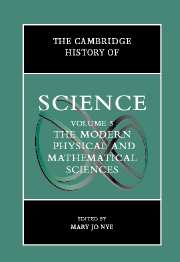Book contents
- Frontmatter
- Introduction: The Modern Physical and Mathematical Sciences
- Part I The Public Cultures of the Physical Sciences After 1800
- 1 Theories of Scientific Method
- 2 Intersections of Physical Science and Western Religion in the Nineteenth and Twentieth Centuries
- 3 A Twisted Tale: Women in the Physical Sciences in the Nineteenth and Twentieth Centuries
- 4 Scientists and Their Publics: Popularization of Science in the Nineteenth Century
- 5 Literature and the Modern Physical Sciences
- Part II Discipline Building in the Sciences: Places, Instruments, Communication
- Part III Chemistry and Physics: Problems Through the Early 1900s
- Part IV Atomic and Molecular Sciences in the Twentieth Century
- Part V Mathematics, Astronomy, and Cosmology Since the Eighteenth Century
- Part VI Problems and Promises at the End of the Twentieth Century
- Index
- References
2 - Intersections of Physical Science and Western Religion in the Nineteenth and Twentieth Centuries
from Part I - The Public Cultures of the Physical Sciences After 1800
Published online by Cambridge University Press: 28 March 2008
- Frontmatter
- Introduction: The Modern Physical and Mathematical Sciences
- Part I The Public Cultures of the Physical Sciences After 1800
- 1 Theories of Scientific Method
- 2 Intersections of Physical Science and Western Religion in the Nineteenth and Twentieth Centuries
- 3 A Twisted Tale: Women in the Physical Sciences in the Nineteenth and Twentieth Centuries
- 4 Scientists and Their Publics: Popularization of Science in the Nineteenth Century
- 5 Literature and the Modern Physical Sciences
- Part II Discipline Building in the Sciences: Places, Instruments, Communication
- Part III Chemistry and Physics: Problems Through the Early 1900s
- Part IV Atomic and Molecular Sciences in the Twentieth Century
- Part V Mathematics, Astronomy, and Cosmology Since the Eighteenth Century
- Part VI Problems and Promises at the End of the Twentieth Century
- Index
- References
Summary
When we consider issues in science and religion in the nineteenth century and even in subsequent years, we naturally think first of the evolutionary controversies that have commanded public attention. However, there are important ways in which developments in physical science continued to intersect with the interests of people of all religious beliefs. Indeed, the closer one approached the end of the twentieth century, the more the interaction between science and religion was dominated by topics involving the physical sciences, and the more they became as important to non-Christian religions as to various forms of Christianity. For the nineteenth century, most issues were new versions of debates that had been introduced long before. Because these reconsiderations were frequently prompted by new developments in physical science, forcing people of religious faith into a reactive mode, the impression grew that religion was increasingly being placed on the defensive. For a variety of reasons, this form of the relationship between the two fields changed greatly over the course of the twentieth century until, at the dawn of the third millennium of the common era, the intersection between science and religion is currently being informed both by new theological perspectives and by new developments in physical science.
Religion intersects with the physical sciences primarily in questions having to do with the origin, development, destiny, and meaning of matter and the material world. At the beginning of the period under review, the origin of matter itself was not regarded as a scientific question. The development of the cosmos, however, or how it had acquired its present contours and inhabitants, was a subject that had been informed by new telescopic observations and even more by the impressive achievements of Newtonian physical scientists of the eighteenth century. The Enlightenment had also produced fresh philosophical examinations of old religious questions and even of religious reasoning itself.
- Type
- Chapter
- Information
- The Cambridge History of Science , pp. 36 - 53Publisher: Cambridge University PressPrint publication year: 2002



